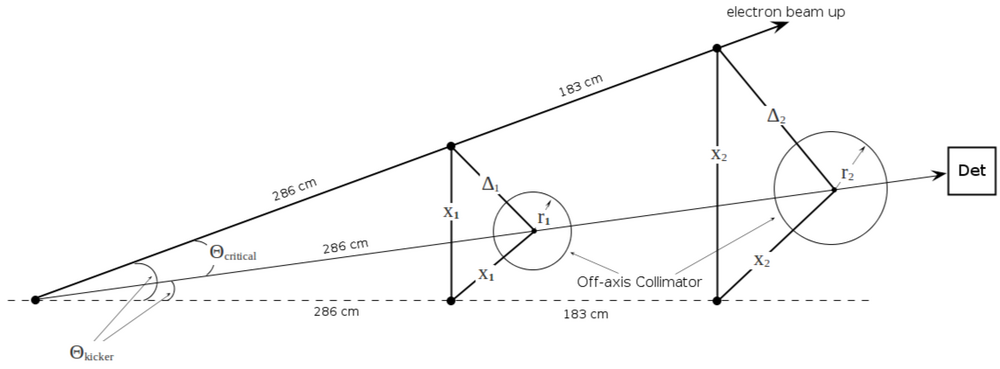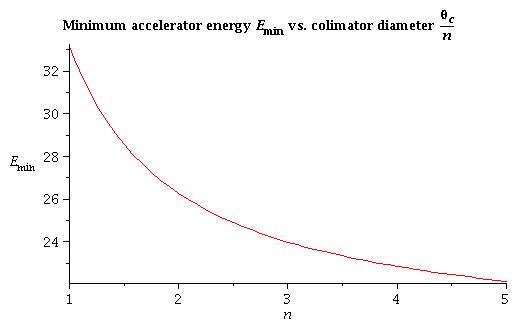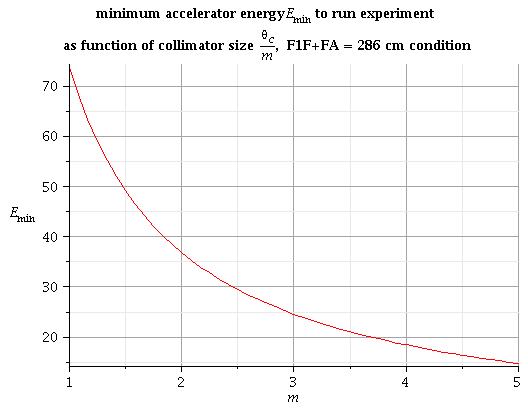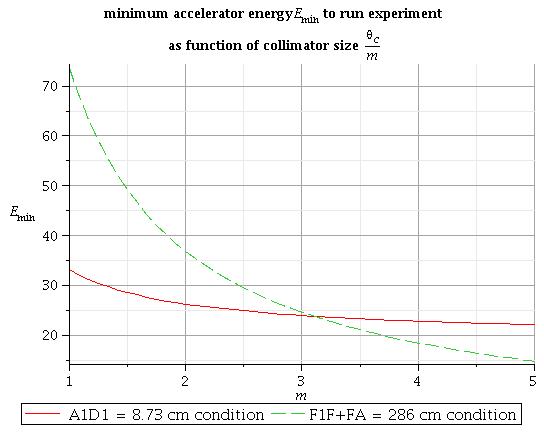Difference between revisions of "Geometry (25 MeV LINAC exit port)"
Jump to navigation
Jump to search
| Line 2: | Line 2: | ||
=Minimum accelerator energy to run experiment= | =Minimum accelerator energy to run experiment= | ||
| + | |||
| + | ==<math>x_2 + r_2<= R</math> condition== | ||
[[File:min_energy.png|1000px]] | [[File:min_energy.png|1000px]] | ||
| Line 24: | Line 26: | ||
\frac{1}{2}\ (286+183)\ \tan\left(\frac{1}{4}\ \frac{0.511}{E_{min}}\right) = 8.73 \Rightarrow E_{min} = 22.8\ MeV </math> | \frac{1}{2}\ (286+183)\ \tan\left(\frac{1}{4}\ \frac{0.511}{E_{min}}\right) = 8.73 \Rightarrow E_{min} = 22.8\ MeV </math> | ||
| − | 4) | + | 4) for arbitrary collimator size: |
[[File:plot_energy_collimatorsize.jpeg]] | [[File:plot_energy_collimatorsize.jpeg]] | ||
| + | |||
| + | All energy above this line is good to run experiment | ||
| + | |||
| + | |||
| + | ==<math>F_1A <= 286\ cm</math> condition== | ||
| + | |||
| + | [[File:plot_energy_F1A.jpeg]] | ||
| + | |||
| + | All energy above this line is good to run experiment | ||
| + | |||
| + | |||
| + | ==both condition above just together== | ||
| + | |||
| + | [[File:plot_energy_bothcondition.jpeg]] | ||
| + | |||
| + | All energy above this lines is good to run experiment | ||
=25 MeV geometry= | =25 MeV geometry= | ||
Revision as of 18:29, 14 June 2010
Minimum accelerator energy to run experiment
condition
The minimum energy of accelerator (MeV) is limited by fitting the collimator () into the hole ()
1) Assuming the collimator diameter is :
2) Assuming the collimator diameter is :
3) Assuming the collimator diameter is :
4) for arbitrary collimator size:
All energy above this line is good to run experiment
condition
All energy above this line is good to run experiment
both condition above just together
All energy above this lines is good to run experiment
25 MeV geometry
geometry calculation
| collimator diameter | |||||||||
|---|---|---|---|---|---|---|---|---|---|
| 4.13 cm | 6.78 cm | 2.92 cm | 4.79 cm | 75 cm | 143 cm | ||||
| 4.13 cm | 6.78 cm | 1.46 cm | 2.40 cm | 136 cm | 203 cm |
geometry pictures
how it looks 1 (, box 3"x4" and then pipe 4")
File:Vacuum pipe collimator .png
how it looks 2 (, box 3"x4" and then pipe 4")
File:Vacuum pipe collimator .png



